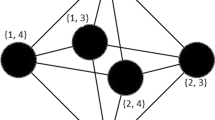Abstract
We show that the quantifier elimination result for the Shelah-Spencer almost sure theories of sparse random graphs \(G(n,n^{-\alpha })\) given by Laskowski (Isr J Math 161:157–186, 2007) extends to their various analogues. The analogues will be obtained as theories of generic structures of certain classes of finite structures with a notion of strong substructure induced by rank functions and we will call the generics Baldwin–Shi hypergraphs. In the process we give a method of constructing extensions whose ‘relative rank’ is negative but arbitrarily small in context. We give a necessary and sufficient condition for the theory of a Baldwin–Shi hypergraph to have atomic models. We further show that for certain well behaved classes of theories of Baldwin–Shi hypergraphs, the existentially closed models and the atomic models correspond.
Similar content being viewed by others
References
Baldwin, J.T.: Fundamentals of Stability Theory, 1st edn. Springer, New York (1988)
Baldwin, J.T., Shelah, S.: Randomness and semigenericity. Trans. AMS 349, 1359–1376 (1997)
Baldwin, J.T., Shelah, S.: DOP and FCP in generic structures. J. Symb. Log. 63, 427–438 (1998)
Baldwin, J.T., Shi, N.: Stable generic structures. Ann. Pure Appl. Log. 79, 1–35 (1996)
Gunatilleka, D.K.: Countable models of Baldwin-Shi hypergraphs and their regular types. Preprint at arXiv:1804.00932 [math. LO] (2018)
Ikeda, K.: A remark on the stability of saturated generic graphs. J. Math. Soc. Jpn. 57, 1229–1234 (2005)
Ikeda, K., Kikyo, H., Tsuboi, A.: On generic structures with the strong amalgamation property. J. Symb. Log. 74, 721–733 (2009)
Laskowski, M.C.: A simpler axiomatization of the Shelah–Spencer almost sure theories. Isr. J. Math. 161, 157–186 (2007)
Niven, I., Zuckerman, H., Montogomery, L.: An Introduction to the Theory of Numbers, 5th edn. Wiley, New York (1991)
Shelah, S., Spencer, J.: Zero-one laws for sparse random graphs. J. AMS 1, 97–115 (1988)
Verbovskiy, V., Yoneda, I.: CM-triviality and relational structures. Ann. Pure Appl. Log. 122, 175–194 (2003)
Author information
Authors and Affiliations
Corresponding author
Additional information
Publisher's Note
Springer Nature remains neutral with regard to jurisdictional claims in published maps and institutional affiliations.
Partially supported by NSF Grant DMS-1308546.
A Some relevant number theoretic facts
A Some relevant number theoretic facts
The number theoretic results concerning Diophantine equations can be found in Chapter 5 of [9] and the number theoretic results concerning continued fractions can be found in Chapter 7 therein.
Remark A.1
We note that in the case all the \(\overline{\alpha }_E\) are rational the equation \(n-{\sum _{E\in L}{\overline{\alpha }_Em_E}}=-\frac{1}{c}\) has infinitely many positive integer solutions, i.e. solutions where n and all of the \(m_E\) are positive. This follows from a straightforward argument using basic number theoretic facts regarding the greatest common denominator, the fact that linear diophantine equations have solutions and \(c=\frac{\prod _{1\le i\le n}q_i}{\prod _{1\le i\le n}\gcd (q_i,\text {lcm}(q_{i+1},\ldots ,q_n))}\).
Remark A.2
Let \(0< \beta < 1\) be irrational. Note that \(\beta \) has a simple continued fraction form \([0:a_1,a_2,\ldots ]=0+1\frac{1}{a_1+\frac{1}{a_2+\cdots }}\) where \(a_i\in \omega \) is positive for \(i\ge 1\). Let \(p_k/q_k=[0:a_1,\ldots ,a_k]\) be the simple continued fraction approximation restricted to k-terms. Now:
-
1.
\(p_k, q_k\) are increasing sequences (and hence \(p_k,q_k\rightarrow \infty \))
-
2.
\(\langle p_{2k}/q_{2k} : k\in \omega \rangle \) is a strictly increasing sequence that converges to \(\beta \)
-
3.
For even k, \(\frac{1}{q_{k}(q_{k}+q_{k+1})}< \beta -\frac{p_k}{q_k} < \frac{1}{q_k q_{k+1}} \)
Now it follows that \( -\frac{1}{q_{2k}}< p_{2k}-q_{2k}\beta < -\frac{1}{q_{2k}+q_{2k+1}}\). This easily yields that \(\lim _{k}p_{2k}-q_{2k}\beta =0\).
Rights and permissions
About this article
Cite this article
Gunatilleka, D.K. The theories of Baldwin–Shi hypergraphs and their atomic models. Arch. Math. Logic 60, 879–908 (2021). https://doi.org/10.1007/s00153-021-00765-8
Received:
Accepted:
Published:
Issue Date:
DOI: https://doi.org/10.1007/s00153-021-00765-8



